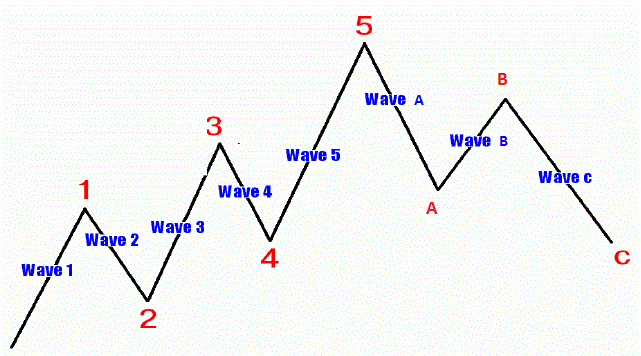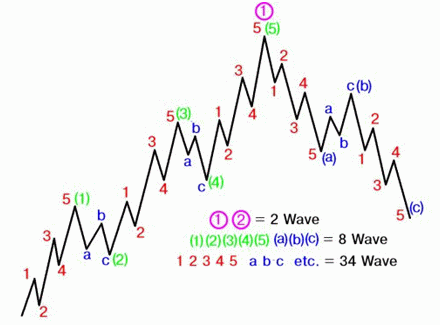Introduction to the Elliott Wave 5-3 Market Pattern
Most of the binary options trading strategies traders use are reactive to market events; such as buy if the price breaks to a new high or low, or buy if the price bounces off a support line for example. But very few techniques have a forecasting ability. Elliott Wave analysis is one of the few technical tools traders can use to develop a map for what is likely to occur in future. While it doesn’t mean you will be able to pin point exact tops and bottoms, or when they will occur, such a map does provide you with an overall context for trends and corrections. For example, a market has been trending higher, and then starts to pullback. What do you do? Elliott Wave can help you determine if the market is likely heading into a full reversal (trend change) or if the move is just a pullback in an overall uptrend that is likely to continue.
Elliott Wave Misconceptions
Many traders cringe when they hear the words “Elliott Wave,” as it can be a little overwhelming at first. To become an expert in this field will take many days, weeks and even years of chart study and practice. But to grasp the basic tenants only takes a short while, and is well worth the effort. Even a basic understanding can help you pick better trades, and avoid some bad ones.
Like everything, there are product salesmen out there telling traders they have found the Holy Grail of trading, found that one strategy that promises you foreknowledge of exact market turning points. Unfortunately Elliott Wave won’t do that for you…and no strategy or method ever will. That said, this form of analysis is predictive and often provides a rough approximation of where pullbacks and trends will begin and end.
5-3 Wave Pattern
While this pattern is often disguised in a sea of choppy movement and price volatility, highly liquid markets generally move in a 5-3 pattern. A 5-3 pattern means that a trend unfolds in 5 waves, and corrections take place over 3 waves. For example, an uptrend will have an up wave (1), down wave (2), up wave (3), down wave (4) and a final up wave (5). Since the trend is moving higher, waves 2 and 4–which are pullbacks–will be smaller than waves 1 and 3 which are impulse waves in the direction of the trend. This overall 5 wave pattern is then followed by sizable correction of 3 waves: down wave (1), up wave (2), down wave (3).
Confused already? Stick with me. There is one more important concept to cover, then we will look at a few illustrations to clear things up. All waves are “fractals.” This means that a 5-3 pattern on a one minute chart may compose just wave 1 on a 15 minute chart. That big 5-wave uptrend you see on a daily chart, may be a Wave 2 move higher in a much longer-term 3-wave correction.
Here are two illustrations to help clear up the basic 5-3 concept of market movements.
Figure 1. Elliott Wave Basic 5-3 Pattern

From the above illustration you can see the general pattern that markets follow. The trend moves up in 5 waves and then corrects in 3–labeled A-B-C. But remember, this is happening on all time frames at the same time, from a tick chart all the way up to yearly and decade charts (and longer). The next illustration shows how this plays out.
Figure 2. Fractal Nature of Markets

A 5 wave pattern creates Wave 1 on a larger time frame. This is followed by a 3-wave correction which creates Wave 2 on that larger time frame, and so on. The 5-3 patterns on a shorter time frame are the building blocks for longer-term 5-3 patterns.
Rules
You may look at a price chart, and notice that markets rarely move in such a well defined way as the illustrations above depict. It’s never quite that easy. The two main problems traders face when they begin using Elliott Wave, and start labeling their charts accordingly, is that A: they either don’t see these patterns at all, or B: they think they see them everywhere but are labeling them all wrong.
While this is article is by no means a full explanation of Elliott Wave analysis, here are a few rules to help label these 5-3 waves.
- Wave 2 never moves beyond the start of Wave 1
- Wave 3 is the never the shortest wave; it must be longer than either Wave 1 or Wave 5, or both.
- Wave 4 never enters the price territory of Wave 1 (in highly leveraged markets you can allow a slight overlap).
If the market is not playing out according to these rules, then you’re likely labelling the chart wrong or the price action is not representative of a 5-3 model on the time frame you are looking at (there are other Elliott Wave patterns which occur within this 5-3 pattern, but are beyond the scope of this article).
Final Word
If you want to increase your forecasting ability, then delve more deeply into Elliott Wave analysis. The definitive book on the subject is Elliott Wave Principle: Key to Market Behaviour by Frost and Prechter. While this form of analysis can be helpful, you don’t need it to trade. I’d actually advise you not to trade based on this methodology until you have researched it fully and practiced your wave counting skills.
Just knowing the basic 5-3 pattern will get you started. Try labeling charts using the method and rules outlined above. Depending on the time frame you’re looking at, you may not always see a 5-3 pattern. That is ok, don’t try to force it. Other patterns also exist, so you may need to shorten or broaden your time frame in order to see the 5-3pattern discussed here.
If you explore further, you’ll find that Elliott Wave can provide profit targets, estimate market turning points and provide a context for all other price movements you see on a charts–such as a triangle or a trading range. You’ll also learn other patterns, such as extensions, diagonals and the multiple forms that corrections can take.